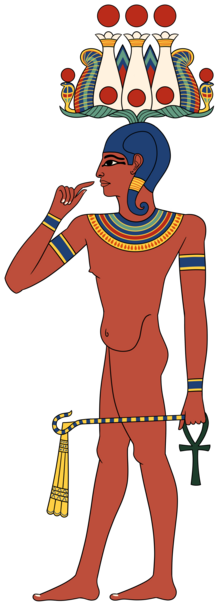| Heka | ||||||||
|---|---|---|---|---|---|---|---|---|
 Heka, depicted wearing a Hemhem crown and sidelock, carrying a crook and flail and ankh. Heka, depicted wearing a Hemhem crown and sidelock, carrying a crook and flail and ankh. | ||||||||
| Name in hieroglyphs | Egyptian: ḥk3w
| |||||||
| Major cult centre | Esna | |||||||
| Genealogy | ||||||||
| Parents |
| |||||||
Heka (/ˈhɛkə/; Ancient Egyptian: ḥkꜣ(w); Coptic: ϩⲓⲕ hik; also transliterated Hekau) was the deification of magic and medicine in ancient Egypt. The name is the Egyptian word for "magic". According to Egyptian literature (Coffin text, spell 261), Heka existed "before duality had yet come into being." The term ḥk3 was also used to refer to the practice of magical rituals.
Name
The name Heka is identical with the Egyptian word ḥkꜣ(w) "magic". This hieroglyphic spelling includes the symbol for the word ka (kꜣ), the ancient Egyptian concept of the vital force. Due to the importance placed onto names in ancient Egypt Heka was often incorporated into personal names. Some examples include: Hekawy, Hekaf, or simply Heka. The goddess Isis is also sometimes affiliated with Heka being titled Weret Hekau, Great Lady of magic.
Beliefs
The Old Kingdom Pyramid Texts depict Heka as a supernatural energy that the gods possess. The "cannibal pharaoh" must devour other gods to gain this magical power. Eventually, Heka was elevated to a deity in his own right, and a cult devoted to him developed.
Creation myths
By the time of the Coffin Texts, Heka is said to have been created at the beginning of time by the creator Atum. Sometimes also being personified as the creator god, presented as a man or child and in some imagery holding two snakes. Heka is also said to be one of the three facets of the creator along with sia and hu.
General myths
Heka is later depicted as part of the tableau of the divine solar barque and as a protector of Osiris in Duat capable of blinding crocodiles.
Then, during the Ptolemaic dynasty, Heka's role was to proclaim the pharaoh's enthronement as a son of Isis, holding him in his arms.
Heka also appears as part of a divine triad in Esna, Ptolemaic and Roman capital of the Third Nome of the Thebaid of Upper Egypt, where he is the son of ram-headed Khnum and a succession of goddesses. His mother was alternately said to be Nebetu'u (a form of Hathor), lion-headed Menhit, and the cow goddess Mehet-Weret, before settling on Neith, a war and mother goddess.
Werethekau whose name means "she who has great magic" is also sometimes connected with the force of Heka.
As Egyptologist Ogden Goelet (1994) explains, magic in the Book of the Dead is problematic: The text uses various words corresponding to 'magic', for the Egyptians thought magic was a legitimate belief. As Goelet explains:
Heka magic is many things, but, above all, it has a close association with speech and the power of the word. In the realm of Egyptian magic, actions did not necessarily speak louder than words – they were often one and the same thing. Thought, deed, image, and power are theoretically united in the concept of Heka.
— O. Goelet (1994)
Gallery
-
 Relief of Heka at the Temple of Esna
Relief of Heka at the Temple of Esna
-
 Heka (ḥkꜣ)
Heka (ḥkꜣ)
-
 Heka, holding two serpents crossing each other with the hind of a lion on nome standard represent his name on his head in the magical form
Heka, holding two serpents crossing each other with the hind of a lion on nome standard represent his name on his head in the magical form
References
- "Projet Rosette - Dictionary detail". projetrosette.info. Retrieved 2017-09-21.
- "Coptic Dictionary Online". corpling.uis.georgetown.edu. Retrieved 2017-09-21.
- "Heka, god of Egypt". landofpyramids.org. Retrieved 2018-01-31.
- Mirecki, Paul; Meyer (2015-08-24). Ancient Magic and Ritual Power. BRILL. p. 49. ISBN 978-90-04-28381-7.
- Riggs, Christina (2020). Ancient Egyptian magic a hands-on guide. Thames & Hudson. p. 23. ISBN 978-0-500-05212-9.
- Shaw, Garry J. (2014). The Egyptian myths A guide to the ancient gods and legends. Thames and Hudson. p. 27. ISBN 978-0-500-25198-0.
- Hart, George (2005). The Routledge Dictionary of Egyptian Gods and Goddesses. Psychology Press. p. 66. ISBN 978-0415344951. Retrieved 22 June 2016.
- Dunand, Françoise; Zivie-Coche, Christiane (2004). Gods and Men in Egypt: 3000 BCE to 395 CE. Cornell University Press. ISBN 978-0801441653.
- Najovits, Simson R. (May 2003). Egypt, Trunk of the Tree. Vol. I: A Modern Survey of and Ancient Land. Algora Publishing. ISBN 9780875862347.
- ^ Ani; et al. (1994) . Goelet, Ogden Jr. (ed.). The Egyptian Book of the Dead: The Book of Going Forth by Day. Translated by Faulkner, Raymond. preface by Carol Andrews (1st ed.). San Francisco, CA: Chronicle Books. p. 145. ISBN 0811807673.
being the Papyrus of Ani (royal scribe of the divine offerings), written and illustrated circa 1250 BCE, by scribes and artists unknown, including the balance of chapters of the books of the dead known as the Theban recension, compiled from ancient texts, dating back to the roots of Egyptian civilization
| Ancient Egyptian religion | |||||||||
|---|---|---|---|---|---|---|---|---|---|
| Beliefs |  | ||||||||
| Practices | |||||||||
| Deities (list) |
| ||||||||
| Creatures | |||||||||
| Characters | |||||||||
| Locations | |||||||||
| Symbols and objects |
| ||||||||
| Writings |
| ||||||||
| Festivals | |||||||||
| Related religions | |||||||||
| Kushite religion | |||||||
|---|---|---|---|---|---|---|---|
| Beliefs |  | ||||||
| Practices | |||||||
| deities |
| ||||||
| Cultures | |||||||
| Locations | |||||||
| Sacred animals | |||||||
| Symbols and objects |
| ||||||
| Languages | |||||||